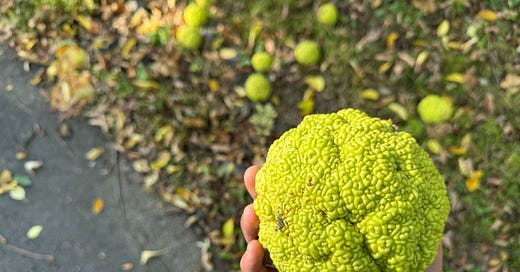An ecological anachronism describes when a species, typically a plant, possesses an adaptation that was once favorable but is less so in the present day. Nature is full of such scenarios, and every autumn I’m reminded of one.
Osage Orange (Maclura pomifera) is a species I encounter fairly often in Pennsylvania. Technically it’s native to some of the south central states like Texas, Oklahoma and Arkansas, but it’s naturalized in the northeast and is more or less treated like it’s native, not dissimilar to how northeasterners have adopted Northern Catalpa as one of their own. This species is rich with interesting features, but inarguably it’s most notable trait is the fact that it produces gargantuan fruit.
Osage Orange fruit.
Perhaps you’ve seen these guys piled up the side of the road. Or maybe you’ve kicked them out of your way during a walk through the park. Or maybe the above photo is the first time you’ve seen them. Whatever the scenario, it should be apparent that the fruit of the Osage Orange is, to put it humbly, an outlier. Few fruits, if any, obtain a comparable size around these parts. Native apples, plums, and cherries all pale in comparison.
So what’s the deal with these overachievers? Well, remember that fruits have evolved to best suit the dispersers of their seeds, whether it be the wind, birds, or in this case, mammals. Once upon a not so distant time, North America was teeming with mighty beasts, many of whom made our bison look diminutive. Mammoths, as you may know, roamed North America and elsewhere for that matter, as early as 10,000 years ago, and the last mammoths disappeared from the earth around 4,000 years ago (look up Wrangel Island when you get the chance). Giant Ground Sloths lived alongside said mammoths, but went extinct around 9,500 years ago.
And while most of North America’s megafauna only exists our imaginations, many of the plants that they utilized are still with us. Species like Kentucky Coffee Tree, Honey Locust, Pawpaw, Persimmon, and of course the focus of this article, Osage Orange, all produce relatively large fruit. Fruit that’s designed to entice suitors that no longer exist, i.e. Mammoths and Giant Sloths.
My daughter with an Osage Orange. Hardly the Mammoth or Giant Ground Sloth they’re intended for.
When I find a pile of Osage Orange fruit, I usually think of mammoths straight away, but then some thoughts of disappointment enter my mind. What a spectacle it would’ve been to see a mammoth, or better yet, to see one in its ecological context, interacting with other plants and animals.
Recently, in a moment of disregard I thought, “surely something must make use of these.” And so, upon finding a pile of “oranges” at a local park, I took two home, placed them in a corner of our yard, and set up a trail cam. What ensued was predictable, sad to say, but interesting nonetheless. Enjoy this video of our backyard fauna, bypassing a relic once useful to so many.
Thanks for reading.
-S. Harris






Really interesting article! I was just wondering what the deal was with the osage orange trees. Love the vid, too!
Great footage - especially like the ones of the fox.